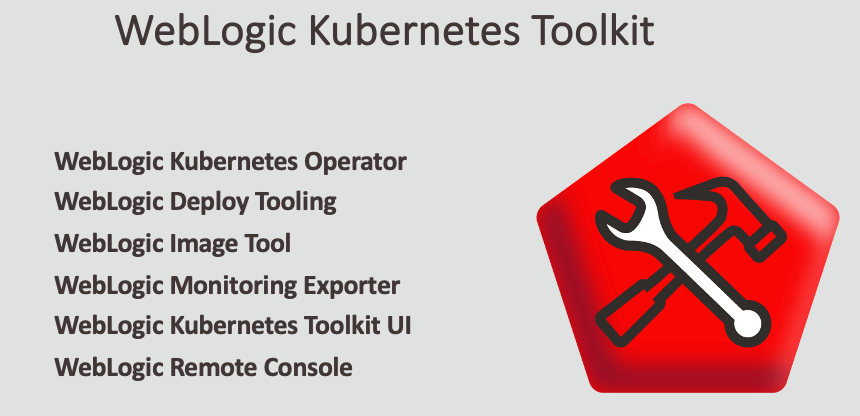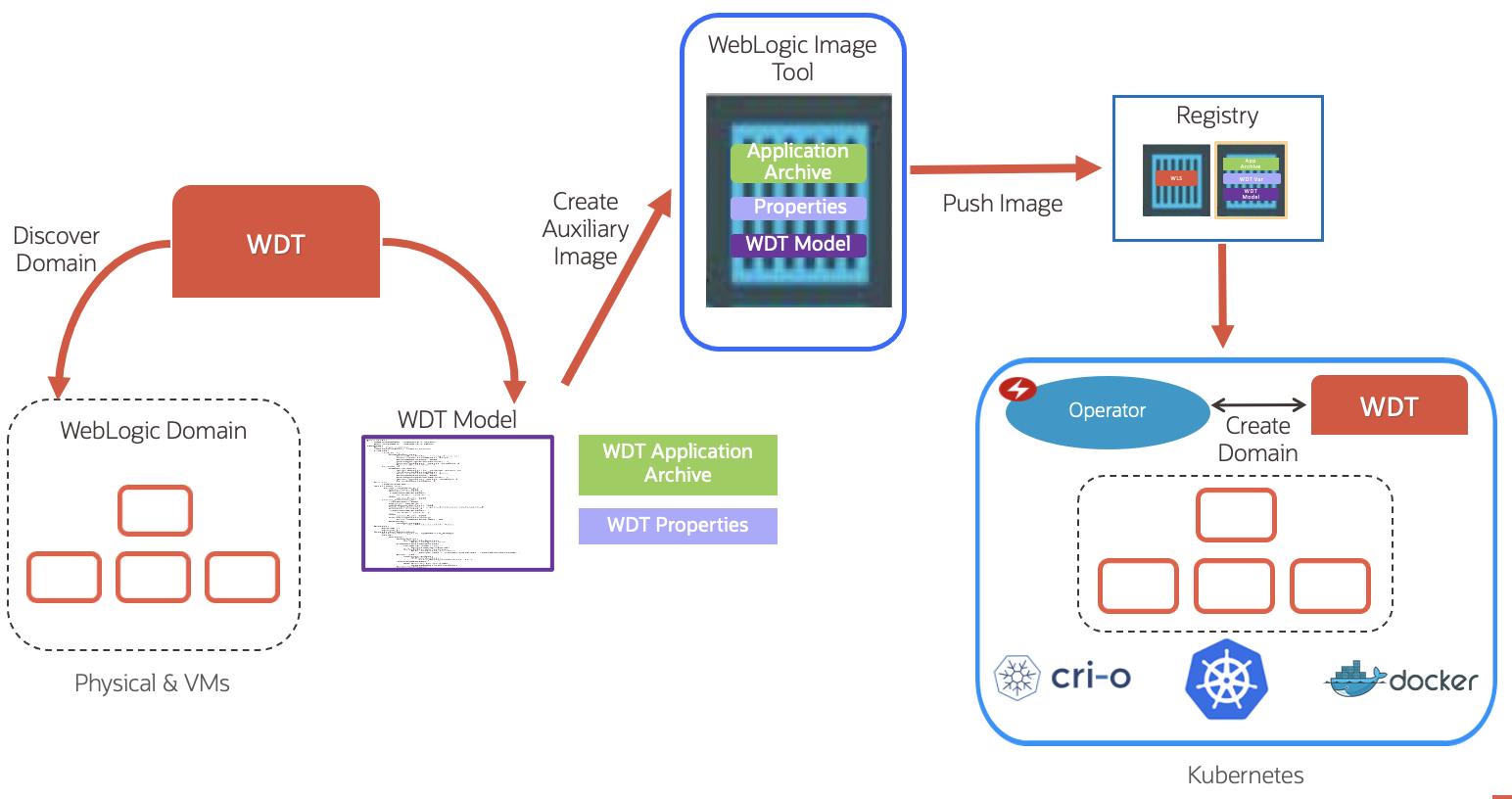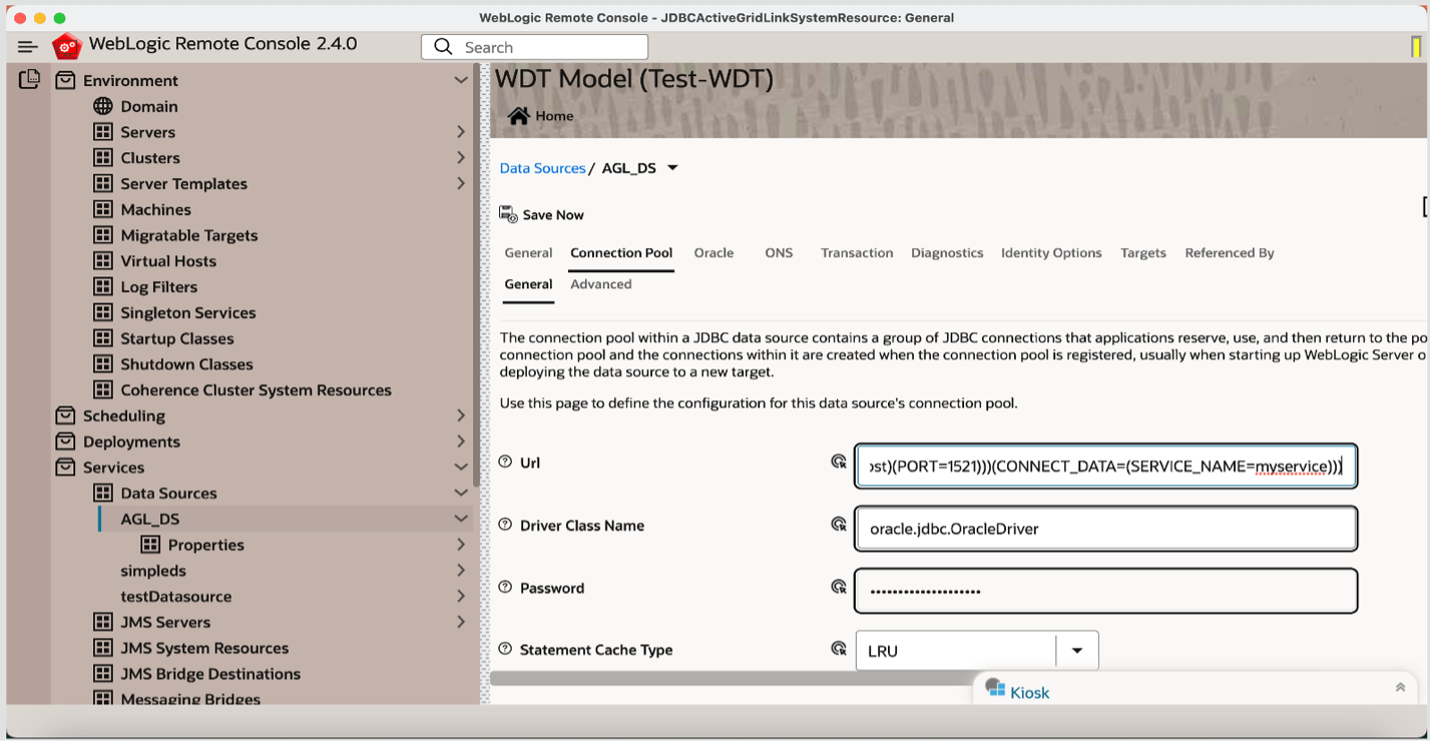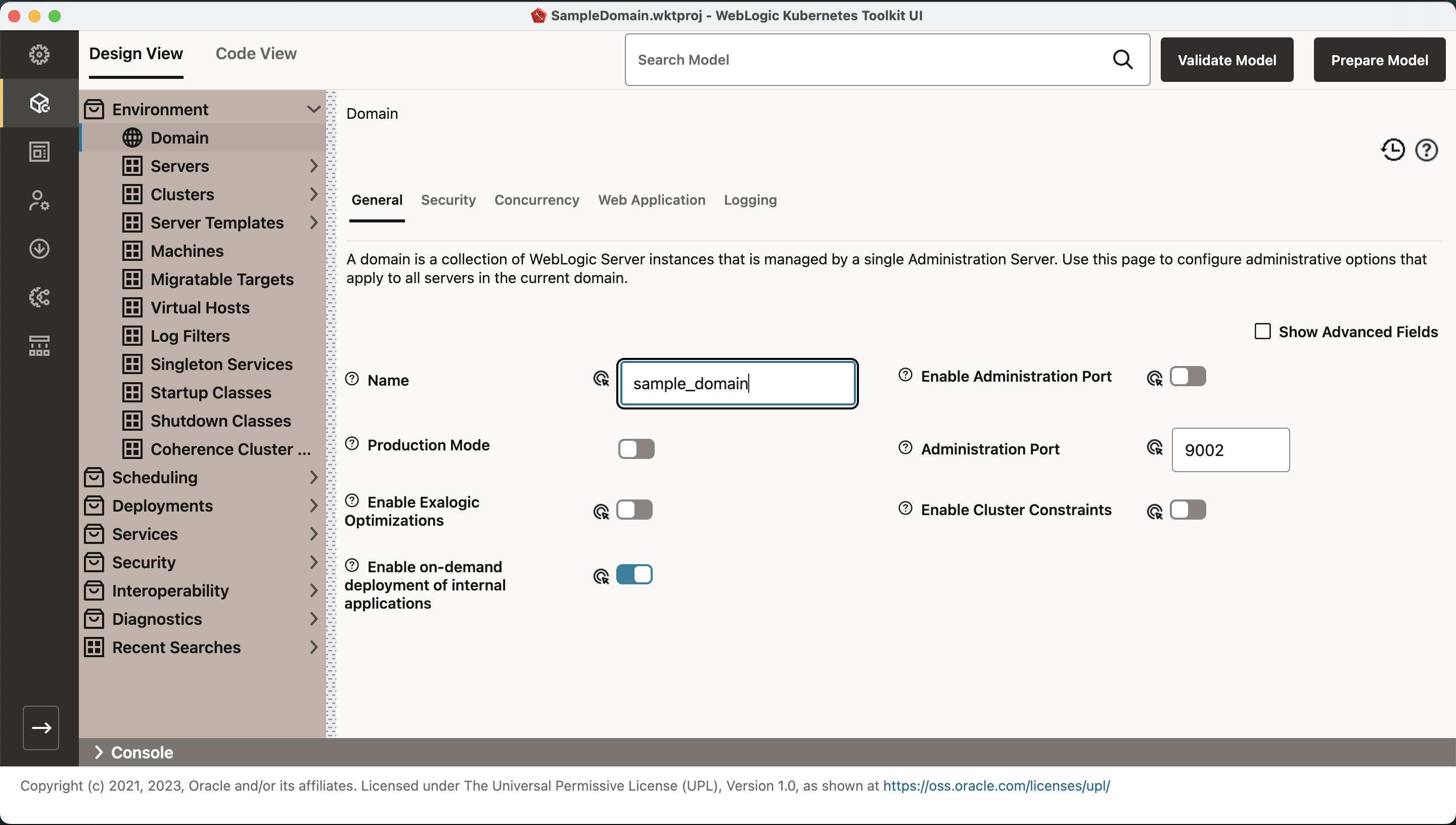We are very excited to announce the release of significant new enhancements to the WebLogic Kubernetes Toolkit (Toolkit). The Toolkit is an integrated set of tools that helps users deploy, manage and update WebLogic Server (WebLogic) domains and applications in Kubernetes. The six tools in the Toolkit are all available in open source and supported with WebLogic Support. Please refer to Doc ID 2790123.1 for Oracle’s Support policy and the Supported Virtualization matrix for supported versions of Kubernetes and Kubernetes vendors. The following includes a description of the Toolkit and recent updates to Toolkit functionality.

WebLogic Kubernetes Operator 4.0.x
The WebLogic Kubernetes Operator (WebLogic Operator) is a Kubernetes controller that extends the Kubernetes API to enable creation, configuration, and management of a WebLogic domain. Please refer to the WebLogic Operator GitHub project and documentation that includes a Quick Start guide and samples.
The WebLogic Operator 4.0.x introduces support for:
- Enhanced and simplified deployment of applications using the Model in Image pattern
- A new Cluster custom resource that allows the WebLogic Operator to manage the lifecycle of a specific WebLogic cluster(s) within the WebLogic domain and provides status information for that cluster.
- Kubernetes Horizontal Pod Autoscaling (HPA) to scale WebLogic clusters based on rules created using WebLogic Server metrics, adding to the autoscaling support provide in prior WebLogic Operator versions.
- New diagnostics, stauses, and events for users to more effectively monitor and maintain their deployments in Kubernetes.
- Enhanced out-of-the-box support for Istio.
- Configuring tolerations for the WebLogic Operator’s deployment.
- Improved retry handling when errors occur.
The WebLogic Operator supports three different domain home source types (patterns): Domain home in PV (DHPV), Domain Home in Image (DHI), and Model in Image (MII). The differences between these patterns are the domain home location and how you update the domain configuration and applications. The MII pattern is the most commonly used pattern and is the pattern we most often recommend.
WebLogic Operator 4.0.x has delivered enhancements to MII pattern to make the deployment of applications simple. The WebLogic Operator creates the domain by using WebLogic binaries included in a Primary image and the WDT model and application binaries included in a separate Auxiliary image. The WebLogic Operator has simplified the structure and implementation of Auxiliary images so that it is straightforward for users to deploy applications using these images.


To make lifecycle management more robust and transparent, WebLogic Operator 4.0.x added diagnostics, statuses, and events for users to monitor and maintain their deployments in Kubernetes. WebLogic Operator 4.0.x also updated handling of retries after a failure providing the ability for a user to fine tune their deployments.
WebLogic Deploy Tooling 2.4.x
WebLogic Deploy Tooling (WDT) makes it easy to stand up WebLogic environments and perform domain lifecycle operations in a repeatable fashion based on a metadata model that can be treated as source and evolve as the project evolves. WDT can be used to introspect a WebLogic domain and applications running in VMs or physical machines and migrate them to images that can run in Kubernetes or Verrazzano. Once the domain is running in Kubernetes, WDT can be used to manage updates to the domain configuration and deploy or undeploy applications. Find documentation and samples in the WDT GitHub project.

WDT 2.4.x added the following enhancements:
- Enhanced the Extract Domain Resource Tool to create custom resource files that are compatible with both WebLogic Operator 4.0 and 3.x.
- Added the ability to do discovery of domains running remotely (on a different machine) from WDT.
- Added the support for changing the RCU Data Source type during JRF domain creation.
The WebLogic Monitoring Exporter 2.1.x
The WebLogic Monitoring Exporter (WME) is a Prometheus-compatible exporter of metrics from WebLogic Server instances. Metrics are obtained by using the WebLogic Server REST APIs. Reference the documentation and samples in the WME GitHub project.
WME can be used to monitor WebLogic Server in Prometheus and Grafana Dashboards and send metrics to HPA to scale WebLogic clusters. If you would like to follow and end-to-end sample refer to the blog Horizontal Pod Autoscaler (HPA) using WebLogic Exporter Metrics.
WME 2.x added the following enhancements:
- The ability to filter metrics it exports to improve performance.
- Improved usability. The WebLogic Operator can inject the WME image into a sidecar in WebLogic server pods to make the use of WME simpler.
The WebLogic Remote Console 2.3.x and 2.4.x
The WebLogic Remote Console (WRC) is a modern, lightweight, open-source console that you can use to manage and monitor your WebLogic Server 12.2.1.3, 12.2.1.4 and 14.1.1 domains. It is offered as an alternative to the WebLogic Server Administration Console (administration console) web application, which Oracle continues to support. For a description of the WRC see the blog and find documentation and “How to get started” in the remote console WRC GitHub project.
When running in Kubernetes it is desirable to use smaller images to minimize the time it takes to push and pull images. WebLogic Server provides slim installers without the administration console to reduce the size of WebLogic Server downloads, installations, Docker images and Kubernetes pods. WRC allows users to configure and monitor domains ran from WebLogic slim images.
WRC 2.3 and 2.4 added the following enhancements:
- Support for creating and updating WDT model files and WDT property files.
- Support for Table customization
- Support searches to easily find any configuration or runtime data.
- The ability to detect referernces to objects in the WebLogic Server configuration. For example, what JDBC store is linked to a JMS Server?
The Toolkit tools all have integration between them to facilitate the provisioning, management, and monitoring of WebLogic domains in Kubernetes. For example, WRC 2.3 and 2.4 integrates with WDT to create and update WDT models and property files from well-known WRC configuration pages.

The WebLogic Kubernetes Toolkit UI 1.4.x
The WebLogic Kubernetes Toolkit UI (WKT UI) provides a graphical user interface that wraps the Toolkit tools, Docker, Helm, and the Kubernetes Command Line Interface (CLI), and guides users through the process of migrating WebLogic Server domains and applications to Kubernetes or Verrazzano. Refer to the blog Announcing the WebLogic Kubernetes ToolKit UI and video demonstration to learn more about the WKT UI and find documentation in the WKT UI GitHub project.
The WKT UI facilitates:
- Introspecting WebLogic Server domains and applications
- Creating WebLogic Server container images
- Provisioning the WebLogic Operator
- Deploying WebLogic Server domains to Kubernetes managed by the WebLogic Operator, including Verrazzano deployments
- Setting up and deploying the software and configurations necessary to deploy and access WebLogic Server domains in your Kubernetes cluster.
The WKT UI 1.4.x added the following enhancements:
- Added support for deploying the WebLogic Operator 4.0.x while still supporting WebLogic Operator 3.4.x.
- Added integration with the WRC to provide the ability to create or update WDT models with well-known console pages
- Added integration with WDT to support introspection of domains that are remote to the WKT UI.

Conclusion
Oracle continues to deliver enhancements and integration between the Toolkit tools, and to provide the ability to make it easier for users to deploy and update their WebLogic applications in Kubernetes and Verrazzano. If you are interested in exploring the use of the Toolkit, the best starting point is to use the WKT UI. This UI leverages the individual tools to manage the entire lifecycle of the domain running in Kubernetes or Verrazzano – from introspecting a domain running in VMs or physical machines, to preparing the model for deployment, to creating images, deploying the WebLogic Operator, deploying the WebLogic domain, and finally deploying Ingress and creating the routing rules to load balance requests to WebLogic servers running in the domain. We hope this announcement is helpful to those of you seeking to deploy WebLogic Server on Kubernetes or Verrazzano, and we look forward to your feedback.
